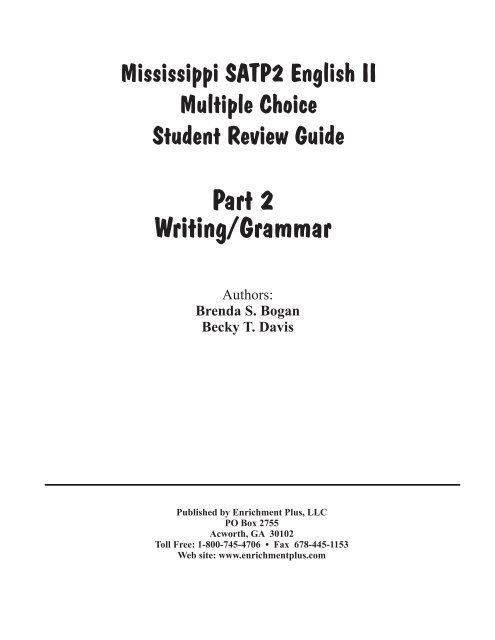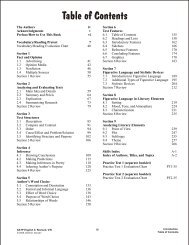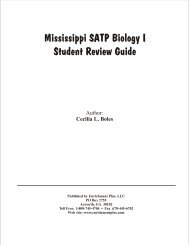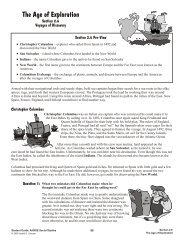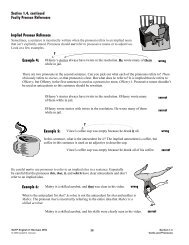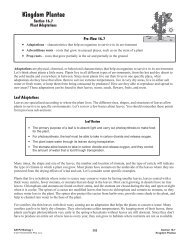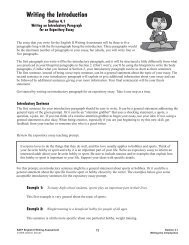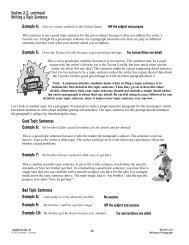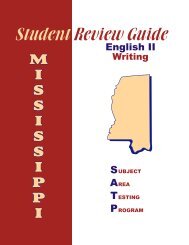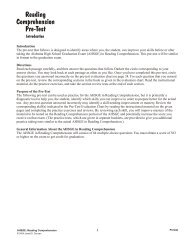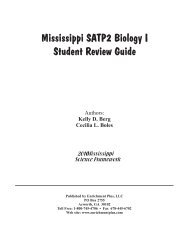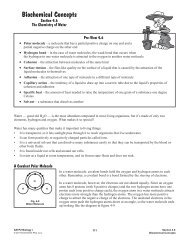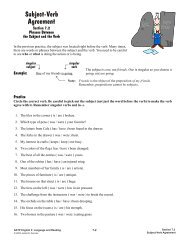Writing/Grammar Pre-Test - Enrichment Plus
Writing/Grammar Pre-Test - Enrichment Plus
Writing/Grammar Pre-Test - Enrichment Plus
You also want an ePaper? Increase the reach of your titles
YUMPU automatically turns print PDFs into web optimized ePapers that Google loves.
Mississippi SATP2 English II<br />
Multiple Choice<br />
Student Review Guide<br />
Part 2<br />
<strong>Writing</strong>/<strong>Grammar</strong><br />
Authors:<br />
Brenda S. Bogan<br />
Becky T. Davis<br />
Published by <strong>Enrichment</strong> <strong>Plus</strong>, LLC<br />
PO Box 2755<br />
Acworth, GA 30102<br />
Toll Free: 1-800-745-4706 • Fax 678-445-1153<br />
Web site: www.enrichmentplus.com
Table of Contents<br />
The Author/Acknowledgments v Section 5<br />
<strong>Pre</strong>face/How to Use This Book vi Simple and Compound Sentences<br />
5.1 Complete Sentences 91<br />
<strong>Writing</strong>/<strong>Grammar</strong> <strong>Pre</strong>test 5.2 Other Fragments 95<br />
<strong>Writing</strong>/<strong>Grammar</strong> Evaluation Chart 26 5.3 Coordinating Conjunctions 97<br />
5.4 Simple and Compound Sentences 98<br />
Section 1 5.5 Purposes of Simple and Compound<br />
Verbs and Pronouns Sentences 103<br />
1.1 Types of Verbs 29 Section 5 Review 105<br />
1.2 Tenses of Verbs: Simple and Perfect 31<br />
1.3 Tenses of Verbs: Progressive and Emphatic 34 Section 6<br />
1.4 Faulty Pronoun References 36 Complex Sentences<br />
Section 1 Review 41 6.1 Introduction to Complex Sentences 107<br />
6.2 Complex Sentences with Adjective<br />
Section 2 Clauses 109<br />
Parts of the Sentence 6.3 Complex Sentences with Adverb Clauses 112<br />
2.1 <strong>Pre</strong>positions and <strong>Pre</strong>positional Phrases 43 6.4 Punctuation with Commas and<br />
2.2 Subjects and Verbs 45 Semi-colons 115<br />
2.3 Active and Passive Voice 48 6.5 Complex Sentences with Noun Clauses 117<br />
2.4 Direct Objects 51 6.6 Purposes of Complex Sentences 119<br />
2.5 Indirect Objects 52 Section 6 Review 122<br />
2.6 <strong>Pre</strong>dicate Nominatives 53<br />
2.7 Objective Complements 54 Section 7<br />
Section 2 Review 56 Verbals<br />
7.1 Participles 125<br />
Section 3 7.2 Infinitives 130<br />
Subject Verb Agreement 7.3 Gerunds 131<br />
3.1 Introduction 59 7.4 Misplaced Modifiers 132<br />
3.2 Phrases Between the Subject and the Verb 61 7.5 Parallel Sentence Parts 135<br />
3.3 Subjects Following Verbs 62 7.6 Sentence Combining 139<br />
3.4 Compound Subjects 63 7.7 Parallelism for Emphasis 141<br />
3.5 Indefinite Pronouns 64 Section 7 Review 142<br />
3.6 Collective Nouns and Other<br />
Noun Exceptions 66 Section 8<br />
3.7 Subject-Verb Agreement in a Effective <strong>Writing</strong><br />
Dependent Clause 68 8.1 Sentence Combining 145<br />
Section 3 Review 70 8.2 Sentence Structure Variety 149<br />
8.3 Parallel Sentence Structure 156<br />
Section 4 Section 8 Review 158<br />
Mechanics<br />
4.1 Capitalization 73 Section 9<br />
4.2 Punctuation with Commas 76 Characteristics of <strong>Writing</strong><br />
4.3 Punctuation with Commas and 9.1 Recognizing Mode 161<br />
Semi-colons 83 9.2 Audience and Purpose for Essays 168<br />
4.4 Punctuation of Direct and 9.3 Point of View 172<br />
Indirect Quotes 85 Section 9 Review 177<br />
Section 4 Review 89<br />
SATP2 English II: W/G<br />
© 2012 <strong>Enrichment</strong> <strong>Plus</strong>, LLC<br />
iii<br />
Introduction<br />
Table of Contents
Section 10 Section 12<br />
Essay Organization<br />
Persuasive Texts<br />
10.1 Content of a Paragraph 183 12.1 Editorials 237<br />
10.2 Planning and Beginning an Essay 189 12.2 Commercial Advertising 240<br />
10.3 Body Paragraphs 195 12.3 Print Advertising 245<br />
10.4 Conclusion Paragraph 198 12.4 Catalog Descriptions 247<br />
Section 10 Review 204 Section 12 Review 249<br />
Section 11<br />
Revisions and Research<br />
11.1 Descriptive Language 209<br />
11.2 Conciseness 214<br />
11.3 Adding and Deleting Information 218<br />
11.4 Comparing and Contrasting Research<br />
Sources 221<br />
Section 11 Review 230<br />
Index A-1<br />
Practice <strong>Test</strong> 1 (separate booklet)<br />
Practice <strong>Test</strong> 1 Evaluation Chart<br />
PT1-23<br />
Practice <strong>Test</strong> 2 (separate booklet)<br />
Practice <strong>Test</strong> 2 Evaluation Chart<br />
PT2-22<br />
What is New in this Edition?<br />
This edition has been revised to reflect the changes made to the English II framework as given in the 2006 Mississippi<br />
Language Arts Framework-Revised. Although some original material has been retained from the original edition, the<br />
teaching material, examples, and practices in this edition have been significantly revised to address the new<br />
framework. This revised edition gives instruction and practice that addresses the maximum depth of knowledge<br />
(DOK) for each competency as indicated by the new framework.<br />
SATP2 English II: W/G<br />
© 2012 <strong>Enrichment</strong> <strong>Plus</strong>, LLC<br />
iv<br />
Introduction<br />
Table of Contents
<strong>Pre</strong>face<br />
The Mississippi SATP2 English II Multiple Choice Student Review Guide for <strong>Writing</strong>/<strong>Grammar</strong> is written to help<br />
students review the skills needed to pass the English II Multiple Choice end-of-course test in Mississippi. This<br />
comprehensive guide covers the required writing and grammar skills (Competencies 3 and 4) as given in the 2006<br />
Mississippi English II Framework (Revised) Competencies specified by the Mississippi State Department of<br />
Education.<br />
How To Use This Book<br />
Students:<br />
The English II end-of-course test is required for graduation. You must pass a multiple-choice exam that tests<br />
vocabulary, reading, writing, and grammar, and you must pass a writing test. This book is a review for Part II of the<br />
multiple-choice portion of the English II test that covers <strong>Writing</strong> and <strong>Grammar</strong> skills.<br />
jTake the pre-test. This <strong>Writing</strong>/<strong>Grammar</strong> pre-test covers writing and grammar competencies as they will be<br />
tested on the end-of-course test (competencies 3 and 4). This pre-test is designed to identify areas that you need<br />
to review.<br />
kScore the pre-test. Using the pre-test evaluation chart, circle the questions that you answered incorrectly.<br />
lFor each question that you missed on the pre-test, review the corresponding sections in the book. Read the<br />
instructional material, do the practice exercises, and take the section review test at the end of each section.<br />
mAfter reviewing the skills, take the two practice tests, which are found in the separate test booklets. These<br />
practice tests are written to look similar to the actual English II multiple-choice end-of-course test; therefore,<br />
they will give you practice in taking the test.<br />
nAfter taking Practice <strong>Test</strong> 1 and/or Practice <strong>Test</strong> 2, use the practice test evaluation charts, which are found<br />
directly after each practice test, to identify areas for further review and practice. The practice test evaluation<br />
charts can be used in the same way as the pre-test evaluation charts.<br />
Teachers:<br />
This review guide is also intended to save you, the teacher, time in the classroom. It can be used for classroom<br />
instruction or for individual student review. Since this student guide offers review for ALL of the writing and<br />
grammar skills specified in the Mississippi Curriculum Framework for the English II course, you have one<br />
consolidated resource of material to help your students prepare for that portion of the end-of-course exam.<br />
jWhen teaching or tutoring individual students, use the strategy outlined above for students. By taking the pretest,<br />
students can identify areas that need improvement. The pre-test evaluation chart directs the student to the<br />
sections they need to review for instruction and additional practice.<br />
kFor classroom study, use this guide to supplement lesson plans and to give additional review for skills required<br />
by the English II Framework Competencies. Purchase a class set of guides for use in the classroom or assign<br />
guides to students for out-of-classroom work.<br />
lAssign the practice tests as comprehensive review tests. Note, the practice tests are bound in separate booklets<br />
for your convenience. Score the tests according to the scoring directions given on pages PT1-1 and PT2-1 of the<br />
test booklets to approximate the scoring potential for the actual SATP test.<br />
mUse the practice test evaluation charts found after each practice test to identify areas needing further review.<br />
nTo establish benchmarks, you may want to use one of the practice tests as a pre-test. Score the practice test<br />
according to the practice test scoring directions given on pages PT1-1 and PT2-1 of the test booklets. Then, after<br />
the students have completed all the exercises in the workbook, use the second practice test to gauge progress.<br />
You should see marked improvement between the initial and final benchmarks.<br />
oPlease DO NOT photocopy materials from these guides. These guides are intended to be used as student<br />
workbooks, and individual pages should not be duplicated by any means without permission from the copyright<br />
holder. To purchase additional or specialized copies of sections in this book, please contact the publisher at<br />
1-800-745-4706.<br />
SATP2 English II: W/G<br />
© 2012 <strong>Enrichment</strong> <strong>Plus</strong>, LLC<br />
vi<br />
Introduction<br />
<strong>Pre</strong>face
<strong>Writing</strong>/<strong>Grammar</strong><br />
<strong>Pre</strong>-<strong>Test</strong><br />
Introduction<br />
Introduction<br />
The pre-test that follows is designed to identify areas where you, the student, can improve your writing and grammar<br />
skills before or after taking the English II Multiple Choice test. This pre-test will be similar in format to Part II of the<br />
SATP2 English II Multiple Choice test. The actual SATP2 English II Multiple Choice test is divided into two parts:<br />
Part I Vocabulary/Reading and Part II <strong>Writing</strong>/<strong>Grammar</strong>. This pre-test tests only Part II, <strong>Writing</strong>/<strong>Grammar</strong>, and does<br />
not contain the same number of questions as on the actual English II SATP2 test. This pre-test contains 40 questions.<br />
The actual test will contain 70 scored questions: 35 for Part I and 35 for Part II, plus 15 unscored field-test questions.<br />
(A pre-test similar to Part I of the actual test can be found in a separate book that covers Vocabulary/Reading<br />
Framework Competencies.)<br />
Directions<br />
Read the directions on the following pages. These directions should be similar to what you will see on the actual<br />
SATP2 for English II. Once you have completed this pre-test, circle the questions you answered incorrectly on the<br />
pre-test evaluation chart on page 28. For each question that you missed on the pre-test, review the corresponding<br />
sections in the book. Read the instructional material, do the practice exercises, and take the section review test at the<br />
end of each section.<br />
Scoring the <strong>Pre</strong>-<strong>Test</strong><br />
The following pre-test is not intended as practice for the actual SATP2 English II test; rather, it is a diagnostic tool to<br />
help you identify which skills you can improve in order to prepare better for the actual test. Any pre-test question<br />
answered incorrectly may identify a skill needing improvement or mastery. Review the corresponding skill indicated<br />
in the <strong>Pre</strong>-<strong>Test</strong> Evaluation Chart by reading the instructional material on the given pages and completing the practice<br />
exercises and reviews. By reviewing each skill, you will improve mastery of the material to be tested on the SATP2<br />
English II Multiple Choice test and potentially increase the score you receive on that test. (The practice tests, which<br />
are given in separate booklets, are provided to give practice taking tests similar to the actual SATP2 English II<br />
Multiple Choice test.)<br />
SATP2 English II: W/G<br />
© 2012 <strong>Enrichment</strong> <strong>Plus</strong>, LLC<br />
7 <strong>Writing</strong>/<strong>Grammar</strong><br />
<strong>Pre</strong>-<strong>Test</strong>
_____________________________________________________________ WG<br />
5<br />
Which of the following is written in the narrative mode?<br />
A To plant your own fruit orchard you must first decide which type of plants you will use. First,<br />
determine how many plants are needed for an acre. Multiply the distance between rows by the<br />
distance between the plants to get the number of square feet allotted to each plant. Then divide the<br />
number of square feet in an acre (which is 43,560) by this number. The quotient will be the number of<br />
plants you will need per acre. Once you have planted your choices, you can sit back and watch them<br />
until time for spraying and harvesting. They will bear plenty of fresh fruit that you will be able to<br />
enjoy for years to come. Happy planting and happy eating!<br />
B My fellow teachers shifted restlessly as I made my way to the table in the front of the room. I clumsily<br />
retrieved the children’s book from my bag and nervously read the story that introduced my topic. I<br />
read hesitantly at first, but soon I forgot the people listening to me as my enthusiasm for my subject<br />
took control. I presented the teachers with new ideas to try in their classrooms. My audience<br />
murmured their approval as I continued to speak and share my ideas. When I stopped speaking, the<br />
group clapped loudly as they got up from their seats to make their way to the next session.<br />
C I cannot participate in the bicycle race this weekend because my aunt and uncle are coming from<br />
Brazil to visit. We haven’t seen them in two years, so we will be celebrating their arrival. They are<br />
staying in our town for a week to go to a cousin’s wedding. I am looking forward to seeing them<br />
again.<br />
D Walking is one of the best exercises that I can do with my spare time. It helps me to release stress and<br />
increases my energy level significantly. I like to walk at night, but it is really not as safe to walk at<br />
night as it is in the day time. Night or day, I have to walk to stay fit and keep off unwanted pounds that<br />
have a bad impact on my health and my closet. Gaining weight from not walking means I only visit<br />
the clothes I like but don’t get to wear them.<br />
A B C D<br />
6<br />
Read this draft of the introduction of a historical essay.<br />
The plague began in England but spread to other continents. It killed millions of people across<br />
several continents, but doctors were powerless to cure or to control the rampaging disease. They<br />
were confused by the multiple ordinary symptoms, mystified about the causes, and appalled at the<br />
severity of the disease.<br />
Which sentence below is appropriate to place at the beginning of this paragraph?<br />
F The Black Plague continues to kill people even in modern times.<br />
G There were diseases, such as the Black Plague, that all had the same symptoms.<br />
H People with strange diseases, such as the Black Plague, were scared when they saw their friends and<br />
family die.<br />
J An ancient disease, the Black Plague, had the power to horrify people all over the world from the<br />
1300s to the 1600s.<br />
F G H J<br />
GO ON<br />
SATP2 English II: W/G<br />
© 2012 <strong>Enrichment</strong> <strong>Plus</strong>, LLC<br />
11 <strong>Writing</strong>/<strong>Grammar</strong><br />
<strong>Pre</strong>-<strong>Test</strong>
WG _____________________________________________________________<br />
36<br />
Which sentence uses only active voice?<br />
F Sam looked around the corner of the barn and smiled slyly when he saw us huddled in the fresh hay.<br />
G Joe had been sitting quietly in his chair before he was called to the stage.<br />
H Sue had been given several chances to make up the test, but she had never followed through with<br />
taking it on either occasion.<br />
J Shawnee was the first to catch the ball, and she was rewarded with a treat.<br />
F G H J<br />
37 In which of the following sentences do the subject and the verb correctly agree?<br />
A<br />
B<br />
C<br />
D<br />
The student body casts their votes for class president.<br />
Some of the apples in the barrel were already rotten.<br />
Nathan and Jerome plays varsity football.<br />
The girls on the cheerleading squad practices after school every day.<br />
A B C D<br />
38 Read the following sentences.<br />
Sentence 1:<br />
Sentence 2:<br />
Sentence 3:<br />
Sentence 4:<br />
Many people from the south like grits for breakfast.<br />
Yesterday my dad read his editorial on television.<br />
We drove west in the direction of the island.<br />
Next year Aunt Catherine will visit us in the spring.<br />
Which of the following correctly identifies the sentence needing additional capitalization?<br />
F Sentence 1 to capitalize the region of the country<br />
G Sentence 2 to capitalize a proper noun<br />
H Sentence 3 to capitalize a direction<br />
J Sentence 4 to capitalize the season<br />
F G H J<br />
GO ON<br />
SATP2 English II: W/G<br />
© 2012 <strong>Enrichment</strong> <strong>Plus</strong>, LLC<br />
26 <strong>Writing</strong>/<strong>Grammar</strong><br />
<strong>Pre</strong>-<strong>Test</strong>
<strong>Writing</strong>/<strong>Grammar</strong><br />
<strong>Pre</strong>-<strong>Test</strong><br />
Evaluation Chart<br />
If you missed<br />
question #:<br />
Go to<br />
section(s):<br />
If you missed<br />
question #:<br />
Go to<br />
section(s):<br />
1<br />
7.1, 7.4<br />
21<br />
12.2<br />
2<br />
2.3<br />
22<br />
11.1<br />
3<br />
10.2<br />
23<br />
11.3<br />
4<br />
10.2<br />
24<br />
10.2, 10.3, 10.4<br />
5<br />
9.1<br />
25<br />
10.2<br />
6<br />
10.1<br />
26<br />
12.2<br />
7<br />
11.4<br />
27<br />
4.2<br />
8<br />
12.2<br />
28<br />
5.5<br />
9<br />
6.6<br />
29<br />
12.4<br />
10<br />
6.6<br />
30<br />
4.2<br />
11<br />
4.2<br />
31<br />
2.7<br />
12<br />
11.2<br />
32<br />
9.3<br />
13<br />
1.4<br />
33<br />
8.1, 8.2<br />
14<br />
10.2, 10.3, 10.4<br />
34<br />
4.3<br />
15<br />
4.4<br />
35<br />
7.2, 7.3, 7.5<br />
16<br />
11.4<br />
36<br />
2.3<br />
17<br />
7.5<br />
37<br />
2.1, 2.2, 3.1, 3.2, 3.4, 3.5, 3.6<br />
18<br />
11.4<br />
38<br />
4.1<br />
19<br />
9.1<br />
39<br />
8.2<br />
20<br />
8.3<br />
40<br />
11.4<br />
SATP2 English II: W/G<br />
© 2012 <strong>Enrichment</strong> <strong>Plus</strong>, LLC<br />
28 <strong>Writing</strong>/<strong>Grammar</strong><br />
<strong>Pre</strong>-<strong>Test</strong>
Section 1.4, continued<br />
Faulty Pronoun References<br />
Implied Pronoun Reference<br />
Sometimes, a sentence is incorrectly written when the pronoun refers to an implied noun<br />
that isn’t explicitly stated. Pronouns should not refer to possessive nouns or to adjectives.<br />
Look at a few examples.<br />
Example 4:<br />
?<br />
OHenry’s stories always have twists in the resolution. He wrote many of them<br />
while in jail.<br />
wrong<br />
There are two pronouns in the second sentence. Can you pick out what each of the pronouns refers to? Them<br />
obviously refers to stories, so that pronoun is clear. But what does he refer to? It is implied that he refers to<br />
OHenry, but OHenry in the first sentence is used as a possessive noun, OHenry’s. Possessive nouns shouldn’t<br />
be used as antecedents so this sentence should be rewritten.<br />
OHenry’s stories always have twists in the resolution. OHenry wrote many<br />
of them while in jail.<br />
OHenry wrote stories with twists in the resolution. He wrote many of them<br />
while in jail.<br />
correct<br />
correct<br />
Example 5:<br />
?<br />
Vince’s coffee cup was empty because he drank it all.<br />
wrong<br />
In this sentence, what is the antecedent for it? The implied antecedent is coffee, but<br />
coffee in this sentence is used as an adjective to describe cup.<br />
Vince’s coffee cup was empty because he drank all of his coffee.<br />
correct<br />
Be careful not to use pronouns to refer to an implied idea in a sentence. Especially<br />
be careful that the pronouns this, that, it, and which have clear antecedents and don’t<br />
refer to an implied idea.<br />
Example 6: Mabry is a skilled acrobat, and that was clear in his video. wrong<br />
What is the antecedent for that? Acrobat is not the antecedent for that and neither is<br />
Mabry. The pronoun that is incorrectly referring to the entire idea that Mabry is a<br />
skilled acrobat.<br />
Mabry is a skilled acrobat, and his skills were clearly seen in his video.<br />
correct<br />
SATP2 English II: W/G<br />
© 2012 <strong>Enrichment</strong> <strong>Plus</strong>, LLC<br />
38 Section 1.4<br />
Verbs and Pronouns
Verbals<br />
Section 7.5<br />
Parallel Sentence Parts<br />
<strong>Pre</strong>-View 7.5<br />
! Parallel structure – having like grammatical parts joined together<br />
Parallel structure means using like grammatical parts to emphasize a similarity between ideas.<br />
Making Series With Coordinating Conjunctions Parallel<br />
When using a coordinating conjunction — and, or, but — in a series, you must always use the same grammatical<br />
elements joined by the conjunction to keep the sentence parallel. A grammatical element could be an adverb, an<br />
adjective, a noun, a prepositional phrase, etc. Don’t get hung up on the names of the grammatical elements. By this<br />
point, however, you should be able to recognize different grammatical elements even if you can’t remember their<br />
exact names.<br />
Example 1:<br />
The man was old, lonely, and a miser.<br />
NOT parallel<br />
adjectives<br />
noun<br />
This sentence is not parallel. It uses the coordinating conjunction and to make three<br />
comparisons about the man. Old and lonely are adjectives, and miser is a noun. You can’t join<br />
adjectives with a noun with and.<br />
You can make this sentence parallel by making all the comparisons adjectives, or you can<br />
reword the sentence by taking out the and. Look at the two corrected sentences below.<br />
The man was old, lonely, and miserly.<br />
parallel<br />
adjectives<br />
The old, lonely man was a miser.<br />
parallel<br />
Example 2:<br />
The model learned to speak well, walking with poise, and that she must apply makeup correctly.<br />
infinitive participial phrase subordinate clause<br />
Is this sentence above parallel? No, it is not parallel because it has different grammatical<br />
elements joined by and.<br />
The model learned to speak well, to walk with poise, and to apply makeup correctly.<br />
infinitives<br />
Is the sentence above parallel? Yes, it is now parallel because the grammatical elements are<br />
all the same type, infinitives (to + a verb).<br />
SATP2 English II: W/G<br />
© 2012 <strong>Enrichment</strong> <strong>Plus</strong>, LLC<br />
135<br />
Section 7.5<br />
Verbals
Verbals<br />
Section 7.6<br />
Sentence Combining<br />
<strong>Pre</strong>-View 7.6<br />
! Correlative conjunctions – conjunctions, such as either . . . or, neither . . . nor, not only . . . but also,<br />
both . . . and<br />
! Parallel – having the same grammatical structure<br />
Combining the ideas from two different statements into one sentence can be an effective writing strategy. You’ve<br />
already seen how to combine statements with both equal and unequal emphasis (in Sections 5 and 6). Now let’s look<br />
more closely at combining statements with equal emphasis by using correlative conjunctions that join verbals or<br />
long prepositional phrases. These types of sentences are usually longer and look a little “messier,” but you have<br />
already practiced the basics. Just remember that when you combine two sentences with verbals or prepositional<br />
phrases, the parts must be parallel (grammatically equal).<br />
Example:<br />
Combine the following two statements into one sentence by giving each equal emphasis.<br />
Statement 1: Hikers traveling to the bottom of the Grand Canyon cannot afford to become<br />
dehydrated.<br />
Statement 2: They also cannot allow their blood sugar to drop.<br />
A good way to combine these statements is to use the correlative conjunctions neither . . . nor. But when<br />
using correlative conjunctions, be careful to make both parts parallel.<br />
Hikers traveling to the bottom of the Grand Canyon can afford neither to<br />
become dehydrated nor to allow their blood sugar to drop.<br />
parallel<br />
Notice that neither to become . . . and nor to allow . . . are parallel because to become and to allow both start<br />
infinitive phrases.<br />
Hint: In many cases, you can look at only the first one or two words after each correlative<br />
conjunction to determine parallelism. First, identify the correlative conjunctions. Then look<br />
at only the first one or two words after them. Ignore the rest of the words.<br />
Hikers traveling to the bottom of the Grand Canyon can afford neither to<br />
become dehydrated nor by allowing their blood sugar to drop.<br />
NOT parallel<br />
Now notice that neither to become . . . and nor by allowing . . . are NOT parallel. To become starts an<br />
infinitive phrase and by allowing starts a prepositional phrase.<br />
Although hikers traveling to the bottom of the Grand Canyon cannot afford<br />
to become dehydrated, they also cannot allow their blood sugar to drop.<br />
NOT equal<br />
There is nothing grammatically wrong with this sentence, but since it is a complex sentence that uses a<br />
subordinate conjunction (although), it does not give both statements equal emphasis. Instead, it gives more<br />
emphasis to the second statement.<br />
SATP2 English II: W/G<br />
© 2012 <strong>Enrichment</strong> <strong>Plus</strong>, LLC<br />
139<br />
Section 7.6<br />
Verbals
Section 8.2, continued<br />
Sentence Structure Variety<br />
Now use the skill of sentence combining to revise a paragraph so that the<br />
sentences have a variety of structures.<br />
Example 8:<br />
Read the following paragraph.<br />
(1) In 1903 Edouard Benedictus, a French scientist, accidentally knocked over a glass<br />
flask. (2) When he looked down to pick up the broken flask, he was astonished to see that all<br />
the broken pieces still held together. (3) The flask had contained a liquid plastic. (4) The clear<br />
plastic had evaporated. (5) A thin coat of the plastic remained in the flask. (6) The plastic was<br />
keeping the broken pieces together. (7) He realized its potential to be useful in the automotive<br />
industry. (8) Most automobile injuries from crashes at that time came from the glass from<br />
broken windshields.<br />
Notice that the first two sentences do not have the same structure; they have variety. But then notice that<br />
sentences 3-8 are all simple sentences with the same structure. How can sentences 3-8 be combined most<br />
effectively to give the paragraph a variety of sentence structures? The ideas from the sentences can be<br />
combined to create more sophisticated sentence structures.<br />
The flask had contained a liquid plastic that had evaporated, and a thin coat of the plastic<br />
remaining in the flask was keeping the broken pieces together. Since most automobile injuries<br />
from crashes at that time came from the glass from broken windshields, he realized its<br />
potential to be useful in the automotive industry.<br />
The five simple sentences have been combined into two complex sentences. The entire paragraph now has a<br />
variety of sentence structures, and no two consecutive sentences have the same pattern.<br />
Example 9:<br />
(1) Just as a book shouldn’t be judged by its cover, the beauty of nature is not always<br />
evident by first appearances. (2) Plants that appear to be weeds during the winter can yield<br />
the most lovely flowers come spring. (3) In the animal world, a peacock’s splendor is only<br />
discovered once he spreads his great tail feathers for display. (4) Sometimes the ordinary can<br />
transform into something quite remarkable. (5) Clumsy cygnets become graceful swans.<br />
(6) Lusterless caterpillars become beautiful butterflies.<br />
Sentences 4-6 are all simple sentences with the same structure. They can also be<br />
improved by sentence combination.<br />
Sometimes the ordinary can transform into something quite remarkable:<br />
clumsy cygnets become graceful swans, and lusterless caterpillars<br />
become beautiful butterflies.<br />
Colons can be used to list examples after a complete sentence. By using a colon<br />
instead of starting a new sentence, you show that the ideas after the colon are direct<br />
examples. Combining sentences in this way is just another method to add variety.<br />
SATP2 English II: W/G<br />
© 2012 <strong>Enrichment</strong> <strong>Plus</strong>, LLC<br />
154<br />
Section 8.2<br />
Effective <strong>Writing</strong>
Section 9.1, continued<br />
Recognizing Mode<br />
Example 1:<br />
On a hot day in August at our favorite spot on the Broad River, the fish<br />
weren’t biting as they usually do, and my brother and I began to fidget<br />
restlessly. After asking our parents for permission, my brother and I quickly<br />
abandoned our fishing poles and scampered our way to an old Indian mound<br />
in search of arrowheads. To our astonishment, we found more than<br />
arrowheads left behind by an ancient civilization. We found ourselves faceto-face<br />
with an apparition that would forever brand our memories.<br />
narrative<br />
This introductory paragraph addresses the prompt and is clearly written in a narrative mode. To address the<br />
prompt, the writer begins to describe an unforgettable childhood memory. The paragraph is narrative because<br />
it describes the setting, a hot day in August at our favorite spot on the Broad River, and it begins to tell a<br />
sequence of events.<br />
Simply writing about childhood or about childhood memories in general would not create a narrative. Look at some<br />
examples that appear to address the topic but are not written in a narrative mode.<br />
Example 2:<br />
Childhood is an important time for all of us to learn new things and<br />
develop our own unique personalities. My own childhood was rich in such<br />
experiences, and I can recall many memories that have shaped who am I<br />
today. These memories document milestones, such as learning to ride a<br />
bicycle and discovering a love for computer games.<br />
not<br />
narrative<br />
By talking about childhood memories in general, this paragraph is not narrative. Notice that it does not tell a<br />
story; it has no setting and no sequence of events.<br />
Example 3:<br />
I will never forget the time I had a parakeet. I named him Teebie and taught<br />
him how to talk. He was so smart that I just left his cage door open so he could<br />
fly out whenever he liked. He would sometimes wake me by pecking me gently<br />
on the lips. He was an amazing bird.<br />
not<br />
narrative<br />
This essay is about a childhood memory of a pet parakeet, but it is not narrative. It is not a story, it does not<br />
have a setting, and it does not tell about an event or a series of events.<br />
Now consider beginning sentences. Can you tell which of these is clearly narrative and which ones are not?<br />
Example 4:<br />
Example 5:<br />
As I watched my best friend ride away with her family in the moving<br />
van, the realization of how different life would be from now on came<br />
crashing into my thoughts.<br />
The day started like any other day, with cereal for breakfast and my<br />
mother’s constant reminders to pack a lunch, but everything changed once the<br />
phone rang.<br />
narrative<br />
narrative<br />
SATP2 English II: W/G<br />
© 2012 <strong>Enrichment</strong> <strong>Plus</strong>, LLC<br />
162<br />
Section 9.1<br />
Characteristics of <strong>Writing</strong>
Revisions and Research<br />
Section 11.1<br />
Descriptive Language<br />
!<br />
!<br />
!<br />
<strong>Pre</strong>-View 11.1<br />
Sensory details – details that appeal to the reader’s sense of sight, smell, hearing, taste, or feel<br />
Colorful modifiers – adjectives and adverbs that give specific and interesting details<br />
Action words – verbs that show specific action; verbs that give the reader a strong sense of the type of<br />
action<br />
A writer’s choice of words can make the difference between boring and interesting. To make writing more effective,<br />
writers often use sensory details, colorful modifiers, and action words. You should also use these strategies in your<br />
own writing.<br />
Sensory Details, Colorful Modifiers, and Action Words<br />
Sensory details are words that appeal to the senses. These words describe sight, smell, sound, taste, or feel. These<br />
types of details give the reader vivid information.<br />
To create sensory details, writers use colorful modifiers and action words. Colorful modifiers are adjectives and<br />
adverbs that give vivid details. Action words are verbs that show specific, vivid action.<br />
Example 1:<br />
Bottles, food containers, and cans were on the bank of the<br />
deserted pond. Green stuff was on part of the shore, and our shoes<br />
partially sank into the mud.<br />
very little<br />
sensory detail<br />
This example uses very few sensory details, and it stirs very little emotion in the reader. Now look at how<br />
adding sensory details can make a huge difference in how you, the reader, experience what you read.<br />
Example 2:<br />
Broken bottles, rotting fast-food containers, and rusting tin cans<br />
littered the bank of the eerily silent, polluted pond. Pond scum<br />
and slimy green algae blanketed parts of the shore, and putrid,<br />
foul-smelling mud oozed around our shoes.<br />
lots of<br />
sensory detail<br />
Look at the underlined sensory details. These details help you not only to “see” the scene but also to get a<br />
sense of sound, smell, and feel. The writer uses a combination of colorful modifiers and action words to create<br />
sensory details:<br />
colorful modifiers<br />
sight: broken bottles, fast-food containers,<br />
rusting tin cans, green algae<br />
smell: rotting, putrid, foul-smelling<br />
sound: eerily silent<br />
feel: slimy<br />
action verbs<br />
sight: littered, blanketed<br />
feel: oozed<br />
SATP2 English II: W/G<br />
© 2012 <strong>Enrichment</strong> <strong>Plus</strong>, LLC<br />
209<br />
Section 11.1<br />
Revisions and Research
Section 11.4, continued<br />
Comparing and Contrasting<br />
Research Sources<br />
Example 4:<br />
Read the research information from these two sources.<br />
Source 1<br />
Types of Steel<br />
Stainless steel –<br />
Tool steel –<br />
HSLA steel –<br />
used in cookware, cutlery, hardware, surgical instruments,<br />
and appliances<br />
used in hand tools, such as axes and pickaxes, metal cutting tools, and<br />
stamping dies<br />
used in cars, trucks, cranes, bridges, and other high stress structures<br />
Source 2<br />
Steel, one of the most widely used metals in modern society, is a metal alloy made of iron<br />
and small amounts of carbon or other elements. Different types of steel vary in strength,<br />
hardness, and corrosion resistance. These different types are created by adjusting the<br />
percentage of carbon as well as by adding additional metals to give it various qualities.<br />
In comparing these two sources, how would you organize and present this information<br />
in a research paper?<br />
A. Use source 1 to define each type, and use source 2 to describe a process.<br />
B. Use source 2 to give a definition and general information, and use source 1 to provide<br />
examples.<br />
C. Determine the main idea in both sources, and compare and contrast the information.<br />
D. Extract the examples given in both sources, and classify the examples into appropriate<br />
categories.<br />
In this case, all you need to do is to understand what each source is giving you. Source 1 gives examples of<br />
uses for different types of steel. Source 2 gives a definition for steel and gives a general explanation of how<br />
different types are made. You should see that answer choice B is correct.<br />
Example 5:<br />
Read the research information from these two sources.<br />
Source 1<br />
Types of Steel<br />
Stainless steel –<br />
Tool steel –<br />
HSLA steel –<br />
contains a high chromium content and is resistant to stains, rust, and<br />
corrosion<br />
known for hardness, resistance to abrasion, and ability to hold a cutting<br />
edge<br />
contains only a small percentage of carbon and has high strength<br />
Source 2<br />
Steel, one of the most widely used metals in modern society, is a metal alloy made of iron<br />
and carbon. In the modern steelmaking process, iron is converted to steel by blowing nearly<br />
pure oxygen into molten iron to lower the carbon and impurity content.<br />
These sources are slightly different. Source 1 gives more specific definitions of the types of steel, and source<br />
2 explains part of the modern steelmaking process. With the answer choices from Example 4, an accurate<br />
contrast of these sources would be Answer choice A.<br />
SATP2 English II: W/G 224<br />
Section 11.4<br />
© 2012 <strong>Enrichment</strong> <strong>Plus</strong>, LLC<br />
Revisions and Research
Section 12.2, continued<br />
Commercial Advertising<br />
General Advertising Guidelines<br />
Almost all advertising is designed to do similar things:<br />
! It introduces the product or service.<br />
! It wants the audience to trust the information being given.<br />
! It wants to convince the audience that they need the product or service.<br />
! It creates a sense of urgency to buy now.<br />
! It wants the audience to remember the product or service for future<br />
purchases.<br />
Of course, not all advertising does all of these things all of the time, but these are general things that most<br />
advertisements will do.<br />
Now, think for a minute about all the television or radio commercials that you can recall. What do you remember<br />
about these commercials? Likely, you remember a clever or catchy saying or a company slogan. Many advertisements<br />
will include sayings or slogans to help you to remember the product, company, or service, and many of these are<br />
persuasive in nature.<br />
The general purpose of all advertising is to get you to buy, but they appeal to specific desires. The advertisement will<br />
use persuasion to target that specific desire, so the beginning, middle, and end will be consistent. For example, is a<br />
product supposed to make your life easier? Then all the parts of the advertisement will try to persuade you of that<br />
idea. Does the advertisement have a theme? Then the beginning, middle, and end will likely have that same theme.<br />
Consider the following examples.<br />
Example 1:<br />
Read the following script for a television commercial.<br />
Stress! It’s the common complaint of most people — young, old, and everyone in between.<br />
What does stress do? It tightens your muscles and gives you headaches. What can you do?<br />
Order our newly-designed, patented NeoNeck Massager. Made from organic cotton and pure,<br />
soft plasticine, it will send gentle vibrations in an even flow to relax your tight muscles. Get<br />
the NeoNeck Massager today; it won’t rub you the wrong way!<br />
This commercial appeals to people who need to relieve stress from tight neck muscles. It implies that people<br />
of all ages have stress, so everyone needs this new product. Notice the catchy ending. It rhymes, and the<br />
ending “it won’t rub you the wrong way” includes an idiom (a common saying) as a play on words. Using<br />
rhyme and an idiom helps the audience to remember the advertisement. Remember, catchy endings are<br />
common ways to end commercials, especially when a company or product wants you to remember it for<br />
future purchases.<br />
Commercial endings will often have catchy phrases. These phrases may use a play on words, such as using an idiom;<br />
they may rhyme; or they may use a repetition of sounds. Example 1 uses both an idiom and rhyme. A repetition of<br />
sounds may be something like “<strong>Test</strong> drive a Toyota today!”<br />
SATP2 English II: W/G<br />
© 2012 <strong>Enrichment</strong> <strong>Plus</strong>, LLC<br />
241<br />
Section 12.2<br />
Persuasive Texts
Section 12 Review, continued<br />
A B C D<br />
9. Read the script for a television commercial.<br />
Nothing says “Happy Birthday” like a homemade cake with luscious icing and colorful<br />
decorations. Store-bought cakes can be dry and tasteless, but making one from scratch<br />
takes too much time. Pick up a homemade, custom-designed cake from The Cake Place.<br />
Call in an order, and it will be ready for pick up in 30 minutes or less. Choose any cake<br />
and icing flavor, and pick one of many hundreds of designs. Party decorations, favors,<br />
and supplies are also available to make any party a complete success.<br />
Which is the most effective and persuasive conclusion for this commercial?<br />
A<br />
B<br />
C<br />
D<br />
Try The Cake Place for your next birthday cake, and you’ll love it.<br />
Planning a birthday party is a piece of cake with The Cake Place.<br />
Order your next birthday cake from The Cake Place instead of buying one from a<br />
supermarket.<br />
The Cake Place isn’t your ordinary bakery.<br />
A B C D 10. Choose the most appropriate and effective catalog description.<br />
A<br />
B<br />
C<br />
D<br />
The amazing new LazR phone offers the most advanced cell phone technology. Like<br />
magic, you can be connected to anyone in the world at the lowest prices ever. The LazR<br />
offers an All-of-It plan that includes unlimited minutes, texting, web browsing, picture<br />
messages, email, video messaging, GPS, and more. All you’ve ever wanted in a cell<br />
phone can now be yours with LazR.<br />
I signed up for a LazR All-of-It plan, and it is amazing. I never dreamed so much<br />
technology could be in such a little package. All my friends are envious of all the features<br />
included on my LazR. The GPS is the best. If you get one, you won’t be sorry.<br />
The new LazR phone with all its technology is amazing. People with little technology<br />
know-how may have some problems at first, but those can all be worked out. There are so<br />
many features with this phone that it will please everyone, and the All-of-It plan is priced<br />
low for every budget. Everybody needs a LazR.<br />
You will want a LazR phone when you see all the features it has to offer. Besides having<br />
the features of a regular cell phone, the LazR has GPS and more. The All-of-It plan is<br />
affordable for what it offers. You will be so glad you have this phone that you will want to<br />
show it off to all your friends. Then they will have to have one, too, and you can share its<br />
technology.<br />
SATP2 English II: W/G<br />
© 2012 <strong>Enrichment</strong> <strong>Plus</strong>, LLC<br />
252<br />
Section 12 Review<br />
Persuasive Texts
WG _____________________________________________________________<br />
11<br />
Read this script for a radio commercial.<br />
Are you tired of spending your hard earned money on the rapidly rising price of gas? If so, try<br />
Rent-A-Scooter instead. For just $25 a month, you can rent one of our electric scooters that will<br />
take you all over the city for a fraction of the cost of using your car, and we are open 24 hours a<br />
day, 7 days a week.<br />
Which sentence is an appropriate and effective conclusion for this commercial script?<br />
A Try us; you’ll be glad you did.<br />
B Rent-A-Scooter offers a clean and efficient ride.<br />
C Realize real savings; ride a Rent-A-Scooter today.<br />
D Ride around town with us and see if you don’t get noticed on your commute.<br />
A B C D<br />
12<br />
Read this draft of a paragraph about Velcro.<br />
(1) In 1941, George de Mestral, after returning from a hunting trip with his dog, took a close<br />
look at the burdock burrs, or seeds, that kept sticking to his clothes and to his dog’s fur. (2) He<br />
examined them under a microscope. (3) He noted their hundreds of hooks. (4) They caught on<br />
anything with a loop. (5) He saw the possibility of using this concept. (6) He could bind two<br />
materials together and then take them apart in a simple fashion. (7) He eventually refined the<br />
process and invented Velcro, a brand name of hook-and-loop fasteners.<br />
For variety in sentence structure, which is an effective combination of sentences 2–7?<br />
F<br />
G<br />
H<br />
J<br />
Examining them under a microscope, he noted their hundreds of hooks that caught on anything with<br />
a loop. He saw the possibility of using this concept to bind two materials together reversibly in a<br />
simple fashion. By refining the process, he invented Velcro, the first brand name for hook-and-loop<br />
fasteners.<br />
He examined them under a microscope and noted their hundreds of hooks. They caught on anything<br />
with a loop. He saw the possibility of using this concept to bind two materials together and then take<br />
them apart. He eventually refined the process and invented Velcro, the first brand name for hookand-loop<br />
fasteners.<br />
He examined them under a microscope. He noted their hundreds of hooks. They caught on anything<br />
with a loop. When he saw that he could use this concept to bind two materials together reversibly, he<br />
refined the process and invented Velcro, the brand name for hook-and-loop fasteners.<br />
When he examined them under a microscope, he noted their hundreds of hooks. These caught on<br />
anything with a loop. He saw the possibility of using this concept. He could bind two materials<br />
together and then take them apart, so he refined the process and invented Velcro, the brand name for<br />
hook-and-loop fasteners.<br />
F G H J<br />
GO ON<br />
SATP2 English II: W/G<br />
© 2012 <strong>Enrichment</strong> <strong>Plus</strong>, LLC<br />
PT1-10<br />
<strong>Writing</strong>/<strong>Grammar</strong><br />
Practice <strong>Test</strong> 1
<strong>Writing</strong>/<strong>Grammar</strong><br />
Practice <strong>Test</strong> 1<br />
Evaluation Chart<br />
If you missed<br />
question #:<br />
Go to<br />
section(s):<br />
If you missed<br />
question #:<br />
Go to<br />
section(s):<br />
1<br />
9.3<br />
21<br />
12.4<br />
2<br />
4.2<br />
22<br />
9.1<br />
3<br />
11.4<br />
23<br />
8.2<br />
4<br />
9.1, 10.2<br />
24<br />
10.2, 10.3, 10.4<br />
5<br />
7.1, 7.4, 7.5<br />
25<br />
3.1, 3.2, 3.4, 3.5, 3.6<br />
6<br />
9.1<br />
26<br />
9.1, 10.2<br />
7<br />
10.1, 10.4<br />
27<br />
11.4<br />
8<br />
11.1<br />
28<br />
9.2<br />
9<br />
6.1, 6.6<br />
29<br />
12.3<br />
10<br />
9.1<br />
30<br />
10.2, 10.3, 10.4<br />
11<br />
12.2<br />
31<br />
11.2, 11.3<br />
12<br />
8.1, 8.2<br />
32<br />
11.4<br />
13<br />
11.4<br />
33<br />
6.1, 6.6<br />
14<br />
2.3<br />
34<br />
1.3<br />
15<br />
10.1<br />
35<br />
4.2<br />
16<br />
5.5<br />
17<br />
8.3<br />
18<br />
12.2<br />
19<br />
7.1, 7.4<br />
20<br />
11.4<br />
SATP2 English II: W/G<br />
© 2012 <strong>Enrichment</strong> <strong>Plus</strong>, LLC<br />
PT1-23<br />
<strong>Writing</strong>/<strong>Grammar</strong><br />
Practice <strong>Test</strong> 1
Competency Correlation Chart (Teacher’s Edition)<br />
The chart below correlates each English II Framework Competency for <strong>Writing</strong> and <strong>Grammar</strong> (as specified by the<br />
Mississippi State Department of Education) to the student guide. The Text Section column gives the section numbers<br />
in the text where each competency is reviewed. The <strong>Pre</strong>test and Practice <strong>Test</strong> columns give the question number(s) in<br />
that test that correlates to each competency. The number in parentheses after the framework competency indicates the<br />
maximum depth of knowledge (DOK), and the number in parentheses after each pre-test and practice test question<br />
number indicates the DOK for that question. (The Mississippi State Department of Education specifies that no less<br />
than 50% of the test questions on the actual test will be at the maximum DOK level.)<br />
Framework Competency<br />
(Max. DOK)<br />
Text<br />
Section(s)<br />
<strong>Pre</strong>-<strong>Test</strong><br />
(DOK)<br />
Practice<br />
<strong>Test</strong> 1<br />
(DOK)<br />
Practice<br />
<strong>Test</strong> 2<br />
(DOK)<br />
3a (3) The student will utilize,<br />
analyze, of evaluate the composing<br />
process.<br />
Subsections 8.1, 8.2<br />
Sections 9, 10<br />
Subsections 11.1,<br />
11.2, 11.3<br />
4(3), 6(3), 12(3),<br />
14(3), 19(3), 22(3),<br />
24(3), 25(3), 32(3),<br />
33(3), 39(3)<br />
1(3), 4(3), 6(3),<br />
7(3),12(3), 15(3),<br />
23(3), 24(3), 26(3),<br />
28(2), 30(3), 31(3)<br />
1(3), 2(3), 6(3), 13(3),<br />
14(3), 16(3),18(3),<br />
19(3), 21(3) , 24(2),<br />
25(3), 29(3), 35(3)<br />
3b (3) The student will compose text<br />
in the narrative mode . . .<br />
Subsections 9.1<br />
Subsections 11.1,<br />
11.3<br />
5(2), 23(3)<br />
8(3), 10(2), 22(3)<br />
3(3), 10(2), 12(3)<br />
3c (3) The student will compose<br />
responses to literature, position<br />
papers, and expository essays in the<br />
informative mode . . .<br />
Subsections 9.1, 9.2<br />
Section 10<br />
3(3)<br />
11(3)<br />
3d (3) The student will compose<br />
persuasive texts for different<br />
audiences using facts and opinions<br />
Section 12<br />
8(3), 21(3),26(3),<br />
29(3)<br />
18(3), 21(3), 29(3)<br />
4(3), 15(3), 32(3)<br />
3e (4) The student will research a<br />
topic comparing and/or contrasting<br />
information from a variety of sources<br />
to present findings<br />
Subsections 11.4<br />
7(3), 16(3), 18(3),<br />
40(3)<br />
3(3), 13(3), 20(3)<br />
27(3), 32(3)<br />
7(3), 17(3), 22(3),<br />
26(3), 31(3)<br />
4a (2) The student will analyze text<br />
to determine the appropriate use of<br />
advanced grammar in composing or<br />
editing<br />
Sections 1, 2, 3<br />
2(2), 13(1), 31(1),<br />
36(1), 37(1)<br />
14(1), 25(1), 34(1)<br />
27(1), 28(2)<br />
4b (1) The student will analyze text<br />
to determine the appropriate use of<br />
advanced mechanics in composing or<br />
editing<br />
Section 4<br />
11(1), 15(1), 27(1),<br />
30(1), 34(1), 38(1)<br />
2(1), 35(1)<br />
9(1), 11(1), 30(1)<br />
4c (2) The student will manipulate<br />
sentence structure to achieve a<br />
purpose such as clarification,<br />
definition, or emphasis in composing<br />
or editing.<br />
Sections 5, 6, 7, 8<br />
1(2), 9(2), 10(2),<br />
17(1), 20(2), 28(2),<br />
35(2)<br />
5(2), 9(2), 16(2),<br />
17(2), 19(1), 33(2)<br />
5(2), 8(2), 20(1),<br />
23(2), 33(2), 34(2)<br />
SATP2 English II: W/G<br />
© 2012 <strong>Enrichment</strong> <strong>Plus</strong>, LLC<br />
A-3<br />
Correlation Chart


